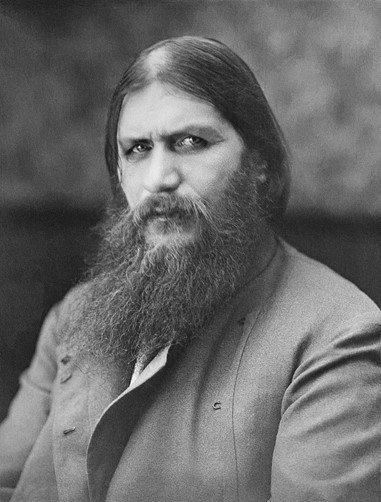
I learned this today. Rasputin managed to gain so much influence over the tsar of Russia because he appeared able to cure the tsar’s son of his hemophilia.
Rasputin was a peasant who managed to rise to become one of the most powerful people in Russia before and during World War 1. In the end he became too powerful, and it led to his death.
Rasputin was born in 1869 and almost nothing is known about him until 1886. He was born a peasant and was illiterate and uneducated. He didn’t learn to read and write until he was an adult. In 1869, he appears in Abalak in Russia and gets married to a peasant girl called Praskovya Dubrovina. They have seven children but four of them die in childhood. Rasputin and Praskovya remain married until his death. She stayed loyal to him even when he moved to St. Petersburg and became powerful. He brought his family to live with him shortly before he was murdered and tried to install them in upper society.
After he died, his wife and two of his children were arrested and sent to a labor camp where they all died. One of his daughters, Matryona, married and left Russia. She moved to France and then America. She spent some time taming lions in P. T. Barnum’s circus, where she used her famous name. “The Mad Monk’s Daughter can tame animals!” She died in 1977.
In 1897, ten years after getting married, Rasputin suddenly had a religious conversion. He travelled to the St. Nicholas Monastery at Verkhoturye and stayed there for several months. The monks taught him how to read and write, but he didn’t like it and headed home. He became a holy wanderer and developed a circle of followers. He started to become renowned as a wise holy man. He used his reputation to get a letter of recommendation to the rector of the St. Petersburg Theological Seminary and moved to St. Petersburg.
Rasputin portrayed himself as a religious mystic and was introduced to aristocratic circles. He was also a very immoral person and something of a womanizer. He had affairs with many aristocratic women. This air of mystery and danger didn’t seem to do his reputation any harm and by 1905, he had managed to form friendships with two princesses that were married to the cousins of Tsar Nicholas II.
He first met the tsar on the 1st November 1905. Rasputin had become famous as a healer as well as a religious figure and the son of the tsar, Alexi, was a hemophiliac. Hemophilia was a common disease in the royal families of Europe and appears to have been passed down by Queen Victoria. It affects only men and was incurable at the time. Hemophilia prevents the body from making blood clots and it can cause death.
Rasputin claimed that he could heal Alexi and, oddly, it actually appears that he did. There were several occasions where Alexi was suffering from internal hemorrhage and Rasputin saved him. There was even an occasion when Rasputin was in Siberia and wrote a telegram that saved the boy. Nobody knows how he did it. He obviously wasn’t really a healer, but experts are at a loss to what he did. The most common theories are that he stopped the bleeding through hypnosis. I have no idea if that is possible. Or that he saved the boy by stopping doctors from seeing him. He wanted to be the only person to heal the boy, so he persuaded the Tsarina to prevent his doctors having access to him. This might have inadvertently helped the boy because the doctors were treating him with aspirin, which was for pain relief, but is also an anti-clotting agent. This wasn’t known at the time, but by shutting out the doctors, Rasputin stopped the aspirin and the boy’s blood may have clotted.
These examples of healing made Rasputin invaluable at court. In 1906, he was put in charge of the lamps in front of religious icons in the palace and he gained more and more power. He started to put his friends in positions of power. The Tsarina believed in his power to such an extent that he could persuade her to do anything he wished, and she, in turn, would persuade her husband.
Rasputin wanted more power and he was accused of sexually assaulting several women. People started to say that he had too much influence over the royal family and the tsar in particular. Still, if it hadn’t been for World War 1, he might have continued on for a while longer.
When Russia entered the war, Tsar Nicholas II took control of the Russian army and left to lead the forces. He left his wife and Rasputin at home to govern. Rasputin persuaded the Tsarina to fire many ministers and the talk of Rasputin’s evil influence grew. It didn’t help that the Tsarina was originally a German princess. There was talk that they were trying to make a peace deal with Germany.
By 1916, a group of nobles had had enough of Rasputin and his influence on the tsarina, and they killed him. Not long after, the Tsar himself would be forced to abdicate and then be killed. If Rasputin had never found his way into the royal family, would things have turned out so badly? Would the Russian revolution have happened? Probably, but who knows.
So, Rasputin managed to gain so much power because he appeared to have the ability to heal Alexi, the son of Tsar Nicholas II of Russia. And this is what I learned today.
Sources:
https://www.rbth.com/history/333666-grigory-rasputins-descendants
https://en.wikipedia.org/wiki/Grigori_Rasputin
https://blog.bridgemanimages.com/blog/what-caused-the-1917-russian-revolutions
https://www.historywiz.com/historymakers/rasputin.htm
https://www.history.com/this-day-in-history/rasputin-is-murdered
https://en.wikipedia.org/wiki/Haemophilia
https://en.wikipedia.org/wiki/Haemophilia_in_European_royalty
